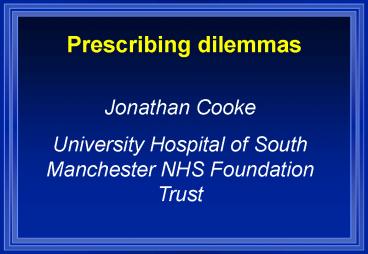Prescribing dilemmas - PowerPoint PPT Presentation
1 / 38
Title:
Prescribing dilemmas
Description:
In the absence of sensitivity tests/inappropriately ... http://www.bsac.org.uk/pyxis/ Healthcare Commission. Medicines Management Indicators ... – PowerPoint PPT presentation
Number of Views:185
Avg rating:3.0/5.0
Title: Prescribing dilemmas
1
Prescribing dilemmas
Jonathan Cooke University Hospital of South
Manchester NHS Foundation Trust
2
Dilemmas in Antimicrobial use
- Antimicrobial use leads to resistance
- Antimicrobials are used in
- Non-infections
- Colonisation and contamination
- In the absence of sensitivity tests/inappropriatel
y - Too many antimicrobials are used empirically
- Broad spectrum agents are used when narrow
spectrum agents will do - Antimicrobials are used for too long
- Antimicrobials are toxic
3
Resistance and antibiotics
4
Quinolone Resistance
E coli
5
(No Transcript)
6
(No Transcript)
7
(No Transcript)
8
(No Transcript)
9
http//www.bsac.org.uk/pyxis/
10
Healthcare CommissionMedicines Management
Indicators
- AHP - 2006
- 21 indicators
- Annual Health Check
- Replaces star ratings
- Number 9 managing antimicrobial prescribing
11
Healthcare Commission Audits 2005/6Medicines
Management Indicator 9Is there good management
of antimicrobials?
- Survey of 173 acute trusts in England
- Score 0 to 5 depending on
- antimicrobial strategy
- clinical guidelines
- surgical guidelines
- 1-3 audit areas covered
- 4-6 audit areas covered
12
Healthcare Commission Acute Hospitals Portfolio -
Medicines Management Progress on Managing
Antimicrobial PrescribingAcute Trusts in England
2005
Good practice
13
IV to Oral Switch
- Appropriate early switching from IV to oral use
- reduce amount and duration of antimicrobials
- reduce duration of stay.
- Known pathogen and sensitivities
- Haemodynamically stable with no signs of fever
- Clinically improving
- Able to take oral medications, have a functional
GI tract with no malabsorption and there is no
conflict or interactions with other medications - Not suffering from certain high-risk infections
14
IV antibiotic point prevalence study UHSM
15
Health Indicators for antimicrobial prescribing
- Process management systems RD, ET
- Clinical Audit process v outcomes
- Clinical Audit qualitative audits
- Clinical Audit quantitative audits
- Outcomes
- Mortality
- Side effects
- Resistance
- Economics
16
Use of Anti-microbials
Acute Hospital trusts in England
17
Oral versus Parenteral
Acute Hospital trusts in England
18
Use of anti-microbials and MRSA
19
Glycopeptides
20
(No Transcript)
21
(No Transcript)
22
(No Transcript)
23
Use of Anti-microbials and C-Diff
Excludes Anti-tuberculous and Anti-leprotic
medicines
24
Use of Anti-microbials and C-Diff
Excludes Anti-tuberculous and Anti-leprotic
medicines
25
Use of Anti-microbials and C-Diff
Excludes Anti-tuberculous and Anti-leprotic
medicines
26
Use of Anti-microbials and C-Diff
Excludes Anti-tuberculous and Anti-leprotic
medicines
27
Use of Anti-microbials and C-Diff
Excludes Anti-tuberculous and Anti-leprotic
medicines
28
(No Transcript)
29
(No Transcript)
30
(No Transcript)
31
(No Transcript)
32
(No Transcript)
33
Health Indicators for antimicrobial prescribing
- High level regional/national
- High level Trust
- Division
- Directorate
- Specialty
- Ward/unit
- Patient
34
Health Indicators for antimicrobial prescribing
easy
- High level regional/national
- High level Trust
- Division
- Directorate
- Specialty
- Ward/unit
- Patient
difficult
35
The Health Act 2006
- Duty to adhere to policies and procedures
- Antimicrobial prescribing
36
DH letter 7th Dec 2006 Healthcare associated
infections, in particular infection caused by
Clostridium difficile
- Antibiotics are only used when indicated by the
clinical condition of the patient and/or in
association with the results of microbial
investigation. - Avoid empiric overuse to reduce the risk of
toxicity and resistance Control of the
prescription of broad-spectrum antibiotics, to
include specifically extended spectrum
cephalosporins and fluoroquinolone antibiotics
37
DH letter 7th Dec 2006 Healthcare associated
infections, in particular infection caused by
Clostridium difficile
- Restrict IV antibiotics to a maximum of 48 hours
in the first instance - IV to oral administration switch guidance
- Oral antibiotics may be restricted to five days
- Most patients should receive only a single
prophylactic dose - timing is crucial
38
Thank You Any Questions?































